Hello… Brossard? Local media outlets have been abuzz with talk of Quebec City based Devimco Inc.’s plans to rip down the gritty industrial neighbourhood (which also happens to be my home) of Griffintown in favour of a development much like its Quartier Dix30 “lifestyle centre” in the South Shore suburb of Brossard.
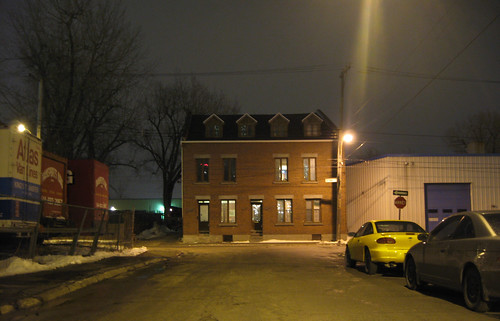
A rowhouse without a row on Ottawa Street in Griffintown. A small stable occupies the empty lot to the left, a newer warehouse is to the right.
For those unfamiliar with Griffintown, you can find it just south of Downtown below Notre Dame Ouest between McGill and Guy streets. At first glance, it would appear that not much is left of Griffintown, which, truth be told, is true. The neighbourhood was once one the densest urban areas in Canada with about 8000 people (mostly Irish) crammed inside cold-water flats amongst factories and stables. Due to various forces from the powers that be, only a few scattered tenements are left. Abandoned and active factories and a couple stables remain amongst newer warehouses and garages, parking lots, and the ever-expanding campus of L’École de technologie supérieure. However, a keen eye and some time spent in the neighbourhood will find a small and quirky community of small businesses, musicians, small scale artisans, students, and a scattering of stubborn old-timers who refuse to give up what little is left.
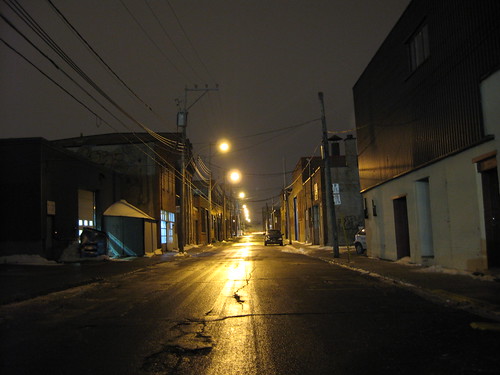
Young Street, Griffintown.
That said, Griffintown is no Plateau and with its proximity to Downtown, there have been numerous plans to redevelop the area. Some development has taken place – a cluster of high-rise condos have been built at the foot of the hill around de la Montagne Street and, as mentioned above, ÉTS has been slowly converting and demolishing buildings to expand their campus. The current proposal for a Dix30 style development has raised a lot of hairs amongst many people in the city so I decided get on my bike and take an afternoon to find out what this Dix30 actually is.
To begin, I quickly realised that the suburbs are no place for bicycles. Although Brossard has a relatively extensive network of bike paths, they tend to be geared more towards recreational cycling and therefore generally do not really go anywhere in particular. Furthermore, their lack of signage and the typically confusing nature of suburbia make them hard to navigate. Motorists are also not used to bicycles on the road; I was almost hit many times and even had a driver throw garbage at me out his car window which ended in me seeking refuge in a blocked off parking lot of an abandoned strip mall after he tried to run me down.
After biking around for about two hours searching for boulevard de Rome, it finally appeared. I asked an older woman which direction I needed to go to find the Dix30. She gave me the directions, adding that she had just visited it for the first time a few days before, and told me that it is huge and I wouldn’t miss it. She described it as being filled with young people and that “it’s like a city…well, no, not like a city, more like a village… but not really”. She commented that she didn’t know what they are going to do in the winter since “it’s all outdoors and there’s no underground, I don’t know if people will want to shop in the cold”. I continued on my way, past newly minted subdivisions and teenagers blasting Limp Bizkit from their Corolas until I saw a big tower surrounded by signless blocks of power centres. The pavement was still black and the outer parking lots abandoned. Only some of the store fronts were occupied, the rest were unfinished and empty, awaiting whatever multi-national chain will take over its pastel coloured box.
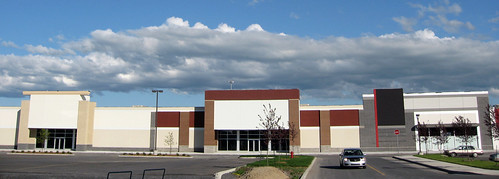
An unfinished strip of stores at Quartier Dix30, Brossard.
I was confused, this looked like any other power centre I had ever seen, albeit on a much larger scale. How would they get away with such a typically suburban development like this in the middle of the city? And how would it fit? It all made sense as I rounded a corner of a massive parking lot where I was immediately confronted with “l’Avenue des Lumières”. To the suburban eye, this is the small town Main Street from the movies, to a more critical eye of an urban dweller (or even someone who lives in an older small town or village) it is a ghastly perversion, a travesty, a parody of urbanity. A mall without a roof with some fancy street furniture.
To my surprise, I found a bike rack. I locked up and wandered around. The street is the length of about 5 city blocks. Along it, traffic is calmed by sidewalk abutments, speed bumps, and a large fountain that one must drive around. Streetside parking is provided, but mostly to create the ambiance of a real commercial street as abundant parking is located everywhere around. Sidewalks are generous with café and restaurant terraces spilling out onto them. The storefronts along the street house chain stores and restaurants but look typical of power centre strips. Each is distinct with different colours and designs, however, no building has a second floor for offices or residences, as would be found on a real main street; l’Avenue des Lumières is a street of consumption and entertainment only.
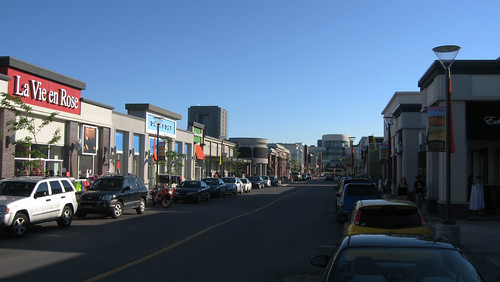
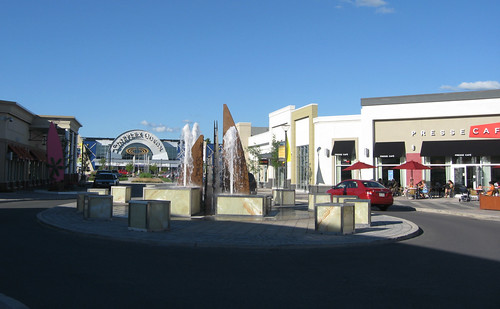
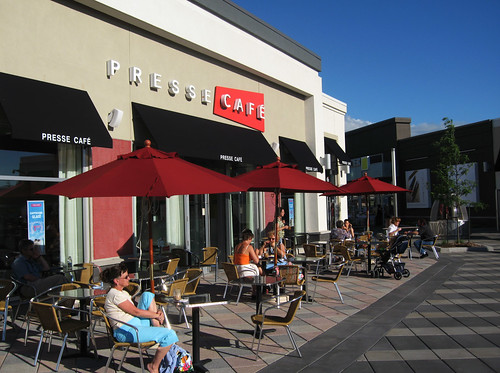
l’Avenue des Lumières.
It is obvious that the developers hired the best designers they could find. The street design and its furniture would make most urban shopping districts jealous. Public art such as a giant sand castle and abstract monuments are scattered around and there is even a small playground where there were a couple children with their parents playing. Sightlines are intelligently designed so you never see empty space, giving the feel of a self-contained place. One end of the street has a large cinema and the other ends with a low-rise office building (still under construction) with a stage for live music in front of it (the tower is to the side so as to not overwhelm the street). Side streets are narrow and distant power centre buildings keep the view from being that of an endless parking lot.
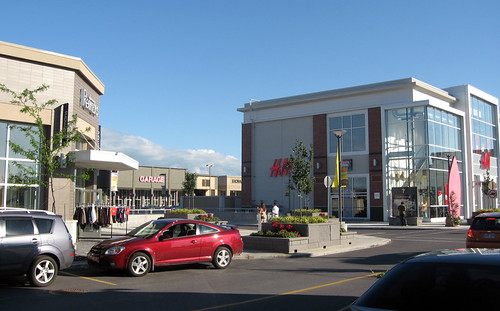
The surrounding power centre breaks the line of sight on a “side street” off l’Avenue des Lumières
Despite the designers’ best intentions, it still feels like a mall. Private security roams in small cars and gave me a strange look while I was taking pictures of the empty stage and the underground parking lot that exits to it. Everything was too clean and polished, and the absence of anyone actually living there could be felt.
Regardless of my contempt for le Quartier Dix30, others seem to like it. There were quite a few people there shopping despite the fact that it isn’t even finished and I’ve heard the various events held there draw a good number of people. While touring one of the new subdivisions sprouting up around the development, I spoke to a man wandering the unfinished streets. When I asked him why he had decided to move to the subdivision, he said that amongst wanting a “maison neuf”, he also wanted to be closer to the Dix30.
So what does this mean for Griffintown? A project of this size and scale will obviously have far reaching effects on the neighbourhood as well as its surrounding areas, especially Downtown. André Poulin, general director of Destination Centre-Ville said to Le Journal de Montréal that he isn’t happy with the idea, saying that the proposed development will have negative effects on downtown businesses, and asks why we need to build such a project so close to Ste-Catherine Street when we have all the businesses we need Downtown. Downtown merchants obviously are not happy either. They say it has taken fifteen years to revitalise Ste-Catherine and such a project will leave the street in its shadow.
Few people would disagree that Griffintown needs some work but this is definitely not the way to go about it. Redevelopment should take the existing fabric of the neighbourhood and build on it, while respecting its history. A development such as this would destroy much of Griffintown’s history and greatly disrupt the urban fabric. A private developer building an entire city district would also bring the issue of public space into question. All public spaces, such as parks, playgrounds, sidewalks, etc. at the Dix30 development is free to use by the general public but its use can be taken away at anytime to anyone at the discretion of the developers. Furthermore, “lifestyle centres” such as this, by their vary nature, cater to the wealthy. Such a development would not benefit the mostly poor and working class residents of the neighbourhood and surrounding neighbourhoods.
Luckily, the project is still in its embryonic stages and would require major revisions to Montreal’s Plan d’Urbanisme before Devimco could proceed. Hopefully, the city will see the inherent problems of such a development and block it. Unfortunately, there may be a great deal of truth in Montreal City Weblog writer Kate McDonnell’s prediction that, despite the development’s problems, “the city may be too hungry for new tax dollars to see [them] clearly”.

10 comments
For what I can tell, Dix30 is a fairly run-of-the-mill lifestyle centre. But there is absolutely no evidence that what will be built in Griffintown will be in any way similar to the development in Brossard. The only connection is the developer! You can thank the Journal de Montréal’s sensational “Un Dix30 à Montréal!” headline for completely skewing the debate. Nothing can confuse and misinform like a bit of hack reporting.
I also wouldn’t trust anything André Poulin has to say. By his own admission, he doesn’t know any more about this Griffintown plan than anyone else so he’s pretty much just running his mouth.
So basically, nobody knows what the plans are for Griffintown because they don’t exist yet.
Incidentally, I have always been curious about Brossard. It’s a typical postwar suburb but it’s also one of the most ethnically diverse municipalities in the Montreal area. A large portion of Montreal’s Chinese community is located there and there is also a sizable population of immigrants from South Asia. I’ve heard Dix30 is hurting business along Taschereau Blvd. I wonder if that will open up retail space for new ethnic businesses?
Great post. It is pretty long. I might suggest breaking the post into two parts so it can be published over two days.
Or you can use the option that allows you to insert the “continue reading” link. It may just add a “more” link.
L’Avenue des Lumières is indeed a very strange place. It will be interesting to see how it might evolve over time. I’ve noticed a trend lately to try and give big box complexes more of a traditional downtown feeling, but that street takes it to an entirely new level.
As cheesy and has hamfisted as it is, I’m not entirely against the concept. It does have the potential of adding a bit of warmth and sense of community to these sorts of places. But because all the stores are the usual big-name retailers (mostly clothing) the whole thing just comes across as cold and awkward. Despite the benches, fountains, public artwork, etc, there really isn’t much going on to help make it feel like the sort of downtown area it’s supposed to represent.
Maybe mixing it up a little by adding things like a grocery store or smaller, independent businesses might help correct things, but I can’t really see that happening anytime soon. Something tells me the developers were a lot more concerned about having it resemble a downtown area than they were about ever having it function like one.
Lifestyle centres like this can never function as real main streets until they become mixed-use (residential, office and retail) and they are connected to the surrounding community (ie, the surrounding parking lots are developed).
The only good thing about places like Dix30 is that, in theory, they can potentially be developed into high-density, mixed-use neighbourhoods. Connect it to the city by transit, develop the parking lots with big apartment blocks and offices, provide smaller retail spaces for independent businesses and there you go. Of course, the problem is that, like a mall, property ownership in Dix30 is centralized and its owners wouldn’t want to take such a big risk.
According to an article in the Gazette that appeared after the sensational article in Le Journal, the developer hasn’t even approached any business/land owners in Griffintown about the project.
The Dix30 is indeed pretty run-of-the-mill as far as lifestyle centres go, actually, it’s probably pretty underwhelming compared to a lot of them, however, for Canada they’re quite novel. I agree with you that a copy of the Dix30 won’t be built in Griffintown but I thinkt we would see is a varation on the theme. This is why I said “Dix30 style development”. Devimco haven’t given many details but I was reading yesterday that someone close to the developer (so take with a grain of salt of course) was talking about a Wal-Mart and other big box chains. We obviously won’t know until announcements are made but I think it is important to discuss.
Brossard is pretty typical of Montreal suburbs. Lots of streets lined with those white, flat-roofed, two story duplexes with garages in the basement as well as single family homes from the ’50s to about the ’70’s. Closer to the Dix30 there are new subdivisions that are still under construction. Boul de Rome acts as an income divide for these new subdivisions, the side that Dix30 is on has smaller houses (although still pretty big) and some town houses. The other side has giant, ugly, over-done McMansions with a pond and foutain. I know there’s an older part of Brossard and even a downtown of sorts but the sun was going down by the time I was leaving so I didn’t get to check it out.
Matt: how do you make the “continue reading” link? I was wanting to do it but couldn’t figure out how it’s done.
Good article..
I have yet to check it out myself, but from what I hear its quite impressive, I’d be very curious to find out how much business is being taken away from the central Ste-Catherine street district. It’s across the bridge and quite difficult to reach via car because of traffic all the time, so I can’t imagine it’s pulling that much business away from downtown. I think we should really be concerned if plans towards a similar development in Griffintown emerge.
Griffintown does not exist. Any reference to it is a romantic idea. Griffintown disappeared before expo when mayor Drapeau decided to demolish the slums and after the completion of the seaway which made the canal redundent. What was Griffintown has been replaced by an urban desert. Somewhat populated during working hours, it remains an abondoned oasis after 5 and on week-ends except for a very few social outcasts who choose to call it home. Most do not know that there ever was a Griffintown or any of it’s history.
The original residents and their families all left for the burbs, toronto and calgary a long time ago.
The church was demolished because there were no more parishoners.
Even the students from the ETS rarely can be seen and almost all the cyclists stick to the canal bike path.
I have lived and worked here for over 30 years and very little has changed except some street names.i.e.Colborne
which became Windsor and then became Peel. There are no grocery stores left, none of the greasy spoons or corner stores, no schools etc.etc.etc.
The only new developments are either condos in old factory buildings(replacing cheap loft and business space) or the ETS which has never managed to get their sign to light up all at the same time (so much for engineering) The residence that was constructed on Peel was done with no imagination (engineering school).
The big Condo project on NotreDame looks as if it was designed from old photos of Stalin’s suburban blocks.
More of the same crass. From McGill until University The government built the cite multi-media on the east side of Griffintown and it sits half vacant in spite of large government subsidies to big business.
I have renamed that neighbourhood empty buildings.com. west of the decaying Bonaventure lie a series of parking lots with the occasional warehouse and the ETS conglomeration.
West of Mountain are the abondoned new post office, which has been sitting empty for at least the last 5 years. It is an enormous warehouse building sitting on the canal,on one of the most polluted sites in Canada heated and maintained year round including 24 hour a day security, gardeners and they even remove the snow. Like cite multi-media,and the ETS guess who pays for this. Griffentown does not exist any longer.
I’ve lived in Montreal my whole life and never heard the area below Notre Dame between Guy and McGill referred to as Griffintown until now. It would be something if this area, which is completely deserted at night, and a has not much appeal, can be revitalized but not with another one of those saturated commercial shopping projects like Dix30. The pics of Dix30 look equally scary for different reasons than the broken down look of Griffintown. There has got to be better ideas out there for a prime location downtown (and don’t say more condos either). We don’t have to say goodbye to Griffintown only hello to New Griffintown.
Would you compare the Quartier Dix30 with the urban sprawl-malls going up in Laval? I will be the first to admit I have never visited the Brossard development, as, you have so graciously explained in your post, it is not very conducive to cyclists.